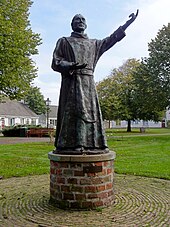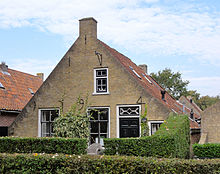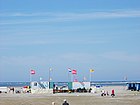Schiermonnikoog
 flag |
 coat of arms |
| province |
|
| mayor | Ineke van Gent ( GroenLinks ) |
| Seat of the municipality | Schiermonnikoog |
|
Area - land - water |
199.07 km 2 37.04 km 2 162.03 km 2 |
| CBS code | 0088 |
| Residents | 932 (Jan 31, 2019) |
| Population density | 5 inhabitants / km 2 |
| Coordinates | 53 ° 29 ′ N , 6 ° 12 ′ E |
| prefix | 0519 |
| Postcodes | 9166 |
| Website | Homepage of Schiermonnikoog |
Schiermonnikoog [ ] ( German "Island of the Gray Monks" ; West Frisian Skiermûntseach , in the local West Frisian dialect Schiermonnikeich ) is one of the West Frisian Islands . At 16 by 4 kilometers, it is the smallest of the five inhabited Dutch Wadden Islands (German " Wadden Islands "). It has 932 inhabitants (as of January 31, 2019) and was named the “most beautiful place in the Netherlands” by the Nederlandse Christelijke Radio-Vereniging in 2006.
history
Isle of the Gray Monks
The island was formed well over 1,000 years ago. As a mudflat island, it has changed significantly in shape and size. Therefore, the oldest parts of today's island are only about 800 years old. It is not known when and by whom Schiermonnikoog was first settled. The name Schiermonnikoog appears for the first time in a document from the Dutch Count Philip the Good . This document from 1440 proves that the island belonged to the abbot of the Frisian monastery Klaarkamp in Rinsumageest near Dokkum . The Cistercian monks wore gray robes. This fact owes the island its name: In West Frisian means almost "gray" monnik "Monk" and oog "island" - "Island of the gray monks". Such a monk adorns the island's coat of arms and since 1961 a bronze statue by the Dutch artist Martin van Waning has been commemorating the monks in the village .
Seizure and private property
The monastery properties were confiscated by the provincial administration in 1580 when the Reformation took hold in Friesland . The province leased the land. In 1638, however, Friesland got so behind with payments for the war in the Dutch Republic that a number of monastery properties had to be sold. Schiermonnikoog was one of them. In 1640 the merchant Johan Stachouwer , who came from Amsterdam , bought the island after two previous owners. Like Ameland , it remained an inheritance in the period that followed . For Johan Stachouwer, the purchase of Schiermonnikoog was an investment . Administration was carried out in his name by a Drost and four mayors. In the 18th century there were marriages between the Stachouwer family and the Tjarda van Starkenborgh regent family of Groningen ; from this the name Tjarda van Starkenborgh Stachouwer arose . From around 1720, today's village of Schiermonnikoog was planned and built on the drawing board, as the first village ( Westerburen , about two kilometers further west) was finally destroyed by constant erosion on the western edge of the island. The oldest preserved house on the island dates from 1721. The first dikes were built in 1767. The Noordertoren and Zuidertoren lighthouses were built in 1853. During the French period, the Stachouwer family lost most of their sovereign rights. However, she remained the owner of the land.
First boom and decline in tourism
In 1858 or 1859 the island was sold to John Eric Banck from The Hague , who in 1860 reclaimed a 260 hectare polder from the Wadden Sea by dike. Banck founded tourism on the island by organizing boat connections to Groningen, renting rooms and building a beach pavilion. Because it had become more and more difficult for the islanders to make a living from fishing and seafaring, the number of inhabitants had consequently fallen sharply. In 1866 Schiermonnikoog was declared a seaside resort; Until Banck had a larger pavilion and new paths built in 1881 that could be used by so-called bathing carriages, only a few guests got lost on the island. With the help of investors, Banck opened a new spa hotel on the beach north of the village in 1887, but then sold the island to the German Count Berthold Hartwig Arthur von Bernstorff-Wehningen in 1892 or 1893 . Despite the efforts of the tourist association founded in 1899 and the traditional Hotel Van der Werff in the village, his family hardly and willingly continued to promote tourism. The island remained in the family's possession for three generations; The construction of a cemetery for castaways and soldiers around 1920 and the construction of the first jetty in 1927 (today a marina) fall in their time. With the loss of the spa hotel to the sea and with the world wars - despite a clear recovery between the wars - tourism practically came to a standstill.
In World War II
During the Second World War , the German occupiers built several bunkers in the dunes as part of the Atlantic Wall . One of them, the bunker called Wasserman since then , was laid as the foundation for the radar device of the same name . Under the code name Schlei , the occupiers built a kind of bunker village with radar posts, anti-aircraft guns and camouflaged barracks northeast of the village at the end of today's Prins-Bernhardweg ; they also put on a narrow-gauge railway. The Wehrmacht crew under the (last) island commander Kapitänleutnant Wittko consisted of 600 men.
When the north of the Netherlands was liberated by Canadian troops in April 1945, a group of around 130 SS men fled to Schiermonnikoog. It was the SD staff of the notorious Scholtenhuis in Groningen . It was not until June 11 that the last 730 Germans were taken to Schiermonnikoog. The 130 SD people were brought to justice and punished. After the war, the island was confiscated by the Kingdom of the Netherlands as Vijandelijk Vermogen (enemy property) in 1945; the von Bernstorff family was expropriated and fled.
Schiermonnikoog today
Schiermonnikoog has been a popular holiday island again since the 1960s (today approx. 300,000 visitors per year) with a beach that is up to one kilometer wide, making it one of the widest beaches in Europe. The main street - Lange Streek - is lined with brick houses from the 18th century. The Rijsbergen manor house on the edge of the village and the old town hall in the center, which are both used as hotels today, have also been preserved. Schiermonnikoog has the usual tourist infrastructure with accommodation, camping, restaurants, shops, museums, events, activities and a ferry connection to Lauwersoog . Visitors cannot take cars to the island, but there are bike rentals, taxis, bus services from some hotels and five bus routes operated by Arriva .
In 2005 the provinces of Groningen and Friesland concluded an agreement in which it was stipulated that the entire area of the island of Schiermonnikoog still belongs to Friesland. This became necessary because the island had grown further east due to sand washes and its eastern tip would otherwise be in the area of the province of Groningen. As a result of the treaty, the maritime border between Friesland and Groningen was moved to the east. Schiermonnikoog has advanced so far to the east in recent years that the eastern part lies at the site of the Bosch island, which sank during the Christmas flood in 1717 .
Schiermonnikoog National Park
In 1989 the Wadden Sea and around 5,400 hectares of the island were designated as a national park. The area includes beaches, the mudflats , dunes , salt marshes and the small lake Westerplas, which was still a salt marsh until 1965, but was separated from the sea by an artificial dune ridge and is now the only freshwater spot on the island. The eastern half of the island is a bird sanctuary and is partially closed from April to July. A forest is also part of the national park area. The last private owner, Count von Bernstorff, had it laid out as a coniferous forest between 1910 and 1920, since coniferous wood was in great demand in mining at the time . In the meantime, the conifers have largely been replaced by deciduous trees, mainly birch, and a mixed forest has emerged.
A visitor center has been set up on the island with an exhibition that provides information about the island's landscape types and offers guided excursions to the national park. In addition to hikes and bike tours, bus rides on the beach (Balgexpres), carriage rides or boat tours can also be undertaken.
The village, the Bancks polder, the area around the village with ice rink, campsite and Berkenplas, and the dune area in the north of the village are not part of the national park. Milk producers are located on the polder, and maize is grown in some places. Large groups of brent and barnacle geese overwinter here .
politics
Distribution of seats in the municipal council
The local elections on March 21, 2018 resulted in the following distribution of seats:
| Political party | Seats | |||||||||
|---|---|---|---|---|---|---|---|---|---|---|
| 1982 | 1986 | 1990 | 1994 | 1998 | 2002 | 2006 | 2010 | 2014 | 2018 | |
| Seeds for Schiermonnikoog | 2 | 2 | 2 | 2 | 3 | 3 | 3 | 3 | 2 | 4th |
| Ons concern | - | - | 1 | 3 | 4th | 3 | 3 | 3 | 4th | 3 |
| Schiermonnikoog's concern | 2 | 1 | 2 | 2 | 1 | 3 | 3 | 2 | 1 | 2 |
| Democrats Schiermonnikoog 2010 | - | - | - | - | - | - | - | 1 | 2 | - |
| Liberaal Schiermonnikoog | 3 | 3 | 1 | 2 | 1 | - | - | - | - | - |
| Schiermonnikoger Volkspartij | - | 1 | 1 | - | - | - | - | - | - | - |
| total | 7th | 7th | 7th | 9 | 9 | 9 | 9 | 9 | 9 | 9 |
mayor
Ineke van Gent ( GroenLinks ) has been the acting mayor of the municipality since September 26, 2017 . The councilors include Johan Hagen (Samen voor Schiermonnikoog), Erik Gerbrands (Schiermonnikoogs Belang) and the municipal secretary Peter Küppers.
literature
- Hans-Jürgen Vogel, Klaas Sikkema: Schiermonnikoog. A small island mosaic . VVV Schiermonnikoog 1999.
- IVN (Ed.): Schiermonnikoog National Park , 2006.
- Bauke Henstra: De oorlog in woord; Schiermonnikoog 1940-1945 , Schiermonnikoog 2010. (Text volume)
- Bauke Henstra: De oorlog in beeld; Schiermonnikoog 1940-1945 , Schiermonnikoog 2010. (illustrated book)
- Rolf Bärenfänger, Johannes Adriaan Mol: The former monastery sites in the coastal area / De voormalige kloosterplaatsen in het kustgebied. In: Land of Discovery. The archeology of the Frisian coastal area pp. 296–309 (2013)
Web links
- Website of the municipality (Dutch)
- Website of the Schiermonnikoog Tourist Association (German, Dutch)
- The history of Schiermonnikoog In: rjhbrink.eu
- Information and photos about Schiermonnikoog In: nordwestreisemagazin.de
- Website of the Schiermonnikoog National Park (Dutch)
- House Rijsbergen, former seat of the island owners (Dutch, German, English)
- Inselparadies Schiermonnikoog: Treasure hunt on the beach , article by Andreas Heimann in Spiegel Online , June 26, 2012
Individual evidence
- ↑ Bevolkingsontwikkeling; regio per maand . In: StatLine . Centraal Bureau voor de Statistiek (Dutch)
- ^ VVV Schiermonnikoog
- ↑ IVN (Ed.): National Park Schiermonnikoog , 2006, p. 9.
- ↑ IVN (Ed.): National Park Schiermonnikoog , 2006, p. 28.
- ↑ Hans-Jürgen Vogel, Klaas Sikkema: Schiermonnikoog. A small island mosaic . VVV Schiermonnikoog 1999, p. 1.
- ↑ Wim Wennekes, Durk Reitsma: Hotel van der Werff, Schiermonnikoog , BoD 2000, p. 39f.
- ^ Wim Wennekes, Durk Reitsma: Hotel van der Werff, Schiermonnikoog , BoD 2000, p. 44f.
- ↑ www.natuurmonumenten.nl/monumenten/bunker-wasserman ( Memento of the original from August 8, 2016 in the Internet Archive ) Info: The archive link was inserted automatically and has not yet been checked. Please check the original and archive link according to the instructions and then remove this notice. Dutch, accessed December 4, 2016
- ↑ bunkermuseum.wordpress.com/
- ↑ IVN (Ed.): National Park Schiermonnikoog , 2006, p. 6.
- ↑ IVN (Ed.): National Park Schiermonnikoog , 2006, p. 3.
- ↑ Result of the local elections: 2014 2018 , accessed on June 19, 2018 (Dutch)
- ↑ Allocation of seats in the municipal council: 1982–2002 2006 2010 2014 2018 , accessed on June 19, 2018 (Dutch)
- ^ Ineke van Gent nieuwe burgemeester Schiermonnikoog. In: waldnet.nl. August 24, 2017. Retrieved June 19, 2018 (Dutch).
- ↑ Collegeleden Gemeente Schiermonnikoog, accessed on June 19, 2018 (Dutch)








